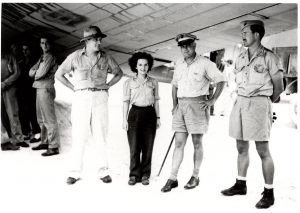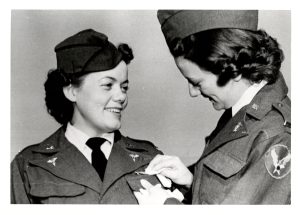Second in a Series of Seven Blogs about Drama in Nursing
Nurse Uniforms
The image of the nurse projected onscreen and on stage – indeed, in mass media in general – is based on a society’s perception of the nurse at the time that the production was staged, or if historical, of what producers perceived to be society’s image of the nurse at the time corresponding with the setting. That image is fluid and has gone through numerous interpretations through the years, not necessarily keeping pace with the advancement of nursing as a profession. The result has been a series of stereotypes attributed to nurses, derived in part from how they are attired when on duty.
Throughout the history of professional nursing, uniforms have played an important part in creating the image that nursing leaders wanted to portray to the public, the patients and the medical staff with whom nurses work. On the opera stage, choice of costume determines in part how the nurse character is perceived. For example, the Nurse in Lulu in the 1996 Glyndebourne production is all business in her starched white uniform and cap and stern behavior in her brief appearance with a team of physicians at Lulu’s bedside during the silent film of the latter’s hospitalization. In the 2010 Flemish Opera production of Cavalli’s Giasone (1649 Venice), Delfa, Medea’s old nurse, is a cross-dressed man wearing an enormous headdress and a woman’s suit with slim knee-length skirt and low-cut blouse, knee-high stockings and high heels on which s/he totters painfully. The “falsies” s/he pulls out to display to men make the lascivious elderly female nurse character all the more comic and tragic. Change in style of nurse uniform or nurse character’s costume over time is one indication of the journey nurses have made toward professionalism. Although few of opera’s nurse characters have reached that status, dress nonetheless can tell us much about their role on stage as well as the status of nursing outside the opera house.
Nurses’ unkempt appearance as well as their disreputable behavior in early nineteenth-century England gave rise to the Sairey Gamp image of the nurse as crude, insensitive, tipsy and immoral. At the opposite extreme were the Roman Catholic nuns attired in their simple, modest tunics and distinctive headgear, suggestive of exemplary behavior founded in religious principles. Writing about the nursing uniform as an instrument of social change, Poplin, whose focus is on the founding of the Kaiswerwerth Deaconness Institute and the image created by its nurses, suggests that an appropriate uniform was vital to the public’s acceptance of the program and of its trained nurses. Fliedner chose a long-skirted blue dress covered by an apron, with a snug white cap, collar and scarf to differentiate his Protestant nurses from the nurses in Roman Catholic sisterhoods dressed in black.
Without a distinctive uniform, Poplin states, “Respectable women could not have overcome the loathsome reputation associated with the “derelicts” hired to do hospital nursing.” Thus, a deaconess’s outward appearance was as important as were her actions. 1 Poplin concludes:
The uniform established an image of respectability and competence for nurses: a necessary antecedent to societal changes that allowed respectable women to be employed as nurses in public hospitals. The nurse uniform was neither a romantic idea nor mere functional attire, but a powerful catalyst for gaining the acceptance of modern nursing as a reputable occupation. 2
As an anonymous article in the American Journal of Nursing (AJN) points out, however, the uniform first had to gain acceptance with its wearers. When Bellevue Hospital School of Nursing in New York City opened its doors in 1873, the gentlewomen whom the faculty was recruiting as their first students had to be handled with kid gloves: “Every effort had to be made to enlist their deepest interests without creating antagonisms.” And the matter of dress was one potential antagonism for women accustomed to finery. But when the beautiful daughter of a prominent family appeared in the smart blue-and-white stripe uniform with white apron and cap, “So charming was she to behold, and so dowdy and insignificant did all the nondescript print dresses look beside her, that prejudice vanished and as rapidly as possible the uniform was adopted, and never again questioned.” 3
According to Claudia Kidwell and Valerie Steele, a nurse’s uniform is as much symbolic as practical: the white uniform adopted by nurses initially represented purity, innocence, and asexuality – prized qualities that the male public attributed to young unmarried women; the apron, sleeve guards and caps contributed to cleanliness; the long skirts and high collars, to respectability. 4 But along the way, the nurses’ functional clothing became as much an emblem of service as a badge of professional status. The first nurse uniforms, for instance, resembled what a proper gentlewoman or a head housekeeper might wear when attending to household duties. 5 A uniform’s meaning depends on its context. 6 To nurse historians Adelaide Nutting and Lavinia Dock, that context is quasi-military. Concerning the adoption of a uniform for the Bellevue nurses, the authors emphasize, “A uniform, however simple, is indispensable, and should be rigidly enforced. It is advantageous on the ground of economy as well as neatness, and its effect on a corps of nurses is the same as on a company of soldiers.” 7 By the twentieth century, nurses on military assignment overseas had taken on the look of a company of soldiers as well when they traded their “whites” for battle fatigues.
Wear of their uniforms had that effect on the army nurses imprisoned in Santo Tomas when it gave them a sense of identity and purpose amid otherwise devastating circumstances. Choice of uniform for nurse characters on the screen and on the opera stage gives an initial indication of the image that the producer wants the nurse character to project – Goffman’s impression management. If this image and the behavior that it represents are reinforced in the showing, it can lead to nursing stereotypes, a type of visual code by which audiences form their own impression of the nurse character. “Because visual coding involves narrative and social values, in nonprint media it also extends to such nonvisual aspects of production as dialogue, music, and even casting.” 8 This applies to opera as well. A number of nurse stereotypes have been perpetuated in the media and are the focus of nursing scholars concerned about their negative effect on the recruitment and retention of students and of nurses in the workplace. The four most common stereotypes discussed in the literature are the nurse as angel of mercy; as doctor’s handmaiden; as battle axe; and as naughty.
The four stereotypes are described in Blogs to follow, with each illustrated in a Hollywood film starring a nurse character.
To learn how the history of nursing was reflected on the opera stage, see Judith Barger, The Nurse in History and Opera: From Servant to Sister (Lexington Books, 2024).
Notes
- Irene Schuessler Poplin, “Nursing Uniforms: Romantic Idea, Functional Attire, or Instrument of Social Change?” Nursing History Review 2 (1994): 153, 254, 157.
- Poplin, “Nursing Uniforms,” 164–65.
- “The Student Nurse’s Uniform’” AJN 11 (November 1940): 1204, 1205.
- Claudia Brush Kidwell, and Valerie Steele, Men and Women: Dressing the Part (Washington, DC: Smithsonian Institutions Press, 1989), 66.
- “The Student Nurse’s Uniform,” 1205. A survey showed that of 277 nursing schools, solid white was worn in 98, and solid blue or blue and white pattern was worn in 147. See ibid., 1207. Blue can be a calming color, symbolizing serenity and reliability.
- Kidwell and Steele, Dressing the Part, 6, 67. The scrubs worn in current times by nursing and housekeeping staff alike blur the distinction between positions.
- Adelaide Nutting and Lavinia L. Dock, A History of Nursing, vol. 2 (London and New York: Putnam, 1907, 400–401.
- Philip A. Kalisch and Beatrice J. Kalisch, The Changing Image of the Nurse (Menlo Park, CA: Addison-Wesley, 1987), 6.



